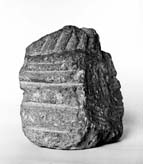Select a site alphabetically from the choices shown in the box below. Alternatively, browse sculptural examples using the Forward/Back buttons.
Chapters for this volume, along with copies of original in-text images, are available here.
Object type: Column base
Measurements: (after R.C.H.M.(E.) 1960, pl. VIII) H. c. 18 cm (7 in); W. and D. Uncertain
Stone type: Purbeck Marble' (ibid.)
Plate numbers in printed volume: Pls. 47-9
Corpus volume reference: Vol 7 p. 99
(There may be more views or larger images available for this item. Click on the thumbnail image to view.)
The decoration consists of a triple incised moulding at the base, a triple moulded collar above, and above that part of a cable, which seems to be the base of a shaft. On one face there is a vertical moulding cut by a deep horizontal groove 1.25 in wide which may have held a pivot, and the opposite face has been cut back.
This could be part of a composite base or capital of a small column. Its stratigraphic position appears to indicate that it can be dated at the latest to the early eleventh century. It is however unlike any other piece in this area. Corfe was an important centre in the later Anglo-Saxon period, and the scene of the murder of King Edward (Whitelock 1979, 230, s.a. 978): it could well have had precocious architecture. If the stone really is Purbeck Marble then the only other example noted in this region is the Sherborne coffin (p. 130).



